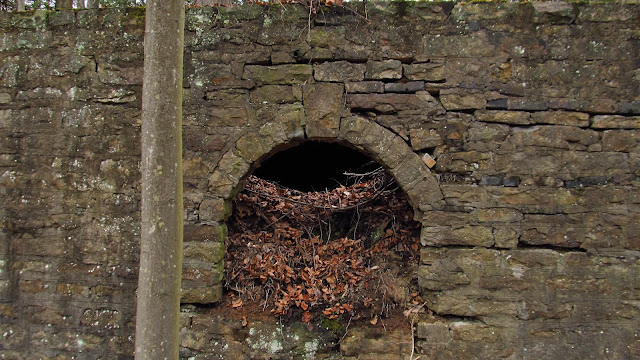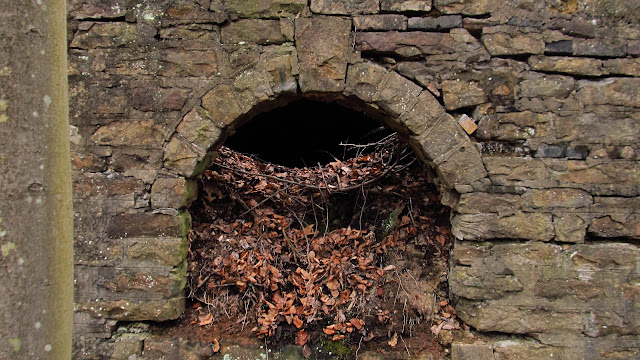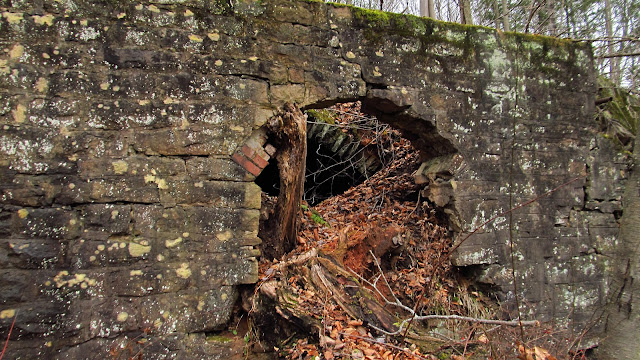Today I took a ride out to Cambria County to look for the Kinport Coke Works. These ovens were built around 1919 by the Hastings Coal & Coke Company of Cherry Tree. Ten years prior to the ovens being built the mine and town of Kinport were constructed.
 |
Indiana County Gazette November 3, 1909 |
50 ovens were constructed and they all remain today in varying conditions. There's no telling if the coke works were operated as long as the mine was. The mine was operating at half capacity as late as 1925 and was still controlled by Hastings. I would imagine the ovens were still being fired just six years after they were built.
 |
Indiana Evening Gazette July 30, 1925 |
The mines were shut down for a period in 1915 due to the tipple burning up.
 |
Coal Age December 11, 1915. |
By 1919 Hastings Coal & Coke Company employed 165 men, five boys and ten girls under the age of 16 at the Kinport mine. According to the Fourth Industrial Census for Pennsylvania, 95 men, from a population of 280 at Kinport, worked at the mine. A 1939 aerial photo of the area shows no activity at the Kinport mine or coke works. The tipple is gone and the works look abandoned. It's relatively safe to say the mine or coke ovens didn't make it to the 1940's.
The following is a portion of the Kinport mine map showing the layout of the ovens and the location of the tipple:
Also detailed are the houses of Kinport as well as the mine buildings. Nothing remains of the mine buildings today. There are a couple houses on Peg Run Road that may be Kinport miners houses.
This is what is left today:
 |
The first couple ovens on the east side of the block. |
 |
Looking south along the coke yard. |
 |
From here down most of the ovens are in pretty decent condition. |
 |
One of those cubby holes that I can never figure out the purpose of. |
 |
This is an interesting example of the decay of a coke oven. Notice how the top collapsed and took half of the arch with it. |
 |
Notice the stone keystone in the arch. This is very uncommon in Pennsylvania coke ovens. Most arches are made from refractory brick or blocks. |
 |
Next to that one was this. Another keystone arch but half of it has fallen out. |
 |
That's a lot of stone. |
 |
A U.R. Lining Brick. |
 |
Looking out toward the old Susquehanna Branch of the Pennsylvania Railroad, now a heavily used hunting road. |
 |
All that and that was only the east side of the block! |
 |
The south end of the block. Half of it is missing. |
 |
The west side of the block. Most of this side is really intact until you get closer to the tipple area. |
 |
This oven has a brick arch. It was probably put in at a later time to replace the stone that had broken down. |
 |
After this is a section where most of the stone is gone. It was probably carted off and used for something else. |
 |
The last two closer to the north end remain fairly intact. |
 |
The north end of the block. |
 |
This is the area on the map where the tipple was located. No evidence of the tipple remains today. |
 |
Looking south down the old rail bed. |
 |
An old utility pole of the old railroad ROW. |
 |
Looking north. |
After this I headed south on 219 toward Northern Cambria. I stopped at the old Lantzy Milling Company to take a couple photos. This three story feed mill was built around 1922-23 by Simon Lantzy. The building is currently for sale.
This is supposedly the third mill on this site. The previous Lantzy Mill burned to the ground on December 17, 1921. Prior to that, there was a water powered mill built in 1870.

Definitely a cool old building.

Definitely a cool old building.
But wait. There's more.
South of Northern Cambria at St. Benedict I came across what I thought were mine ruins. It turns out these great buildings were built by the Northern Cambria Railway Co. during the 1910's.
In 1906 the Northern Cambria Railway Company started streetcar service in Barnesboro ( now Northern Cambria). The small streetcar service operated 13 miles of track and served Barnesboro, Spangler, St. Benedict, Carrolltown and Patton. When the company was chartered, the investors agreed to provide service to Carrolltown if the Southern Cambria Railway Co. made the connection from Ebensburg to Carrolltown. This would provide service from Johnstown to Barnesboro. However, once the Southern Cambria Railway Co. reached Ebensburg sometime after 1910, unexpected construction expenses prevented the final link to be completed. During this time the Northern Cambria Railway Co. had already built a car barn, engine room and a boiler room large enough to accommodate the expected junction with the Southern Cambria Raliway Co. When the venture failed, the Northern Cambria Railway Co. struggled to meet the operating expenses for this large plant. The company continued to operate into the 1920's but dissolved on July 31, 1926.
(Source: Blair and Cambria County, Pennsylvania- An Inventory Of Historic Engineering And Industrial Sites; HABS/HAER National Park Service)
 |
This is the largest of the three buildings and was the car barn. |
 |
The buildings are getting framed and all that amazing brickwork is getting covered up. The car barn is on the left, the other two are the engine and boiler rooms. |
 |
Sections of the mine dumps laying around. Lots of red dog everywhere. |
 |
A look at the back sides of the buildings. |
 |
Some metal objects sticking out of the ground. |
 |
This must have been used for servicing trolley cars. |
 |
There is track on the top of it. |
 |
And old cement pads for piers below it. |
 |
The back side of either the boiler or engine house. |




















































Mike, I grew up in Carrolltown. My Dad was born in 1911 between Patton and Carrolltown in a little patch called Ashcroft and was a miner in the area all his life. When I was a kid I remeber him telling me those large yellow brick buildings in your beautiful photos were car barns for a trolley car service that ran in the area for a brief period of time. The trolley went between Patton and what is now called"Northern Cambria" but back in the day was known as Barnesboro and Spangler. FYI. Paul
ReplyDeleteNo kidding? That's even cooler. I just went off the mine dump nearby. I remember looking at those garage doors thinking they were big enough for a train. I never would have guessed it was a trolley barn. Thanks Paul. I'll switch it up.
DeleteI grew up in Elizabeth Twp. Have ever checked the Warren Mine site? Your doing a wonderful job.
ReplyDeleteThanks Jud, I stopped by the Warden Mine one day while I was working and checked it out. I haven't had a chance to get back there but I'd really like to.
DeleteMike, Mebbe those buildings were used for minining purposes after the trolley service closed? You now that trolley also stopped at the Sunset Ballroom, which was located between Carrolltown and Patton. There's nothing there now but the place was a real big deal, major music attractions appeared there,eg - Duke Ellington, Guy Lombardo, Dorsey Brothers etc. Kinda was the equivalent of a major concert hall venue today, probably could accomodate 1000-2000 people.A big barn like structure.
ReplyDeleteWow! It's amazing the way those old artists used to tour. You always here of the big stars of the day playing the small towns but that's where the fans were. That was all swing and big band, pretty much the top 40 of the day, a hell of a lot better than popular music today. Even the country stars playing little honky tonks and bars pretty much anywhere. Good stuff!
DeleteMy grandfather was a coal miner in hastings, I love learning about the mining in the area, he passed when I was very young, I used to play at the Coke ovens in hastings, they tore them down years ago, I really miss them
ReplyDelete